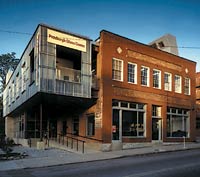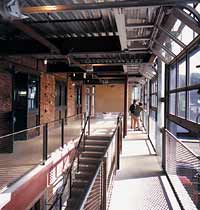Specifying Ceilings: From Classic to Curved
Although all the winners seem to address the 10 measures to some degree, different aspects of sustainability are pursued more rigorously from one to the other, depending on localized opportunities and constraints. Of the three winners highlighted below, for example, University of Florida's Rinker Hall, in Gainesville, basks in daylighting; the Austin shelter flouts innovative materials and a visually striking storm-water runoff system; and the Pittsburgh glass studio keeps its cool-in the face of blistering heat-with convection-induced airflows. Rylander underscores the fact that sustainable design does not lend itself to universal solutions, but rather to the key environmental issues of a unique place. "COTE is really interested in understanding how these projects begin to express what it means to build in a particular region," he adds.
|
There were some surprises in this year's contest. First, there were only eight announced award recipients rather then the typical 10, due not to a dearth of good projects but to a technical glitch relating to the application of new eligibility requirements that was uncovered only after the jury had made its final selections. Also unexpected, the jurors decided to offer a special commendation to Lloyd Crossing Sustainable Urban Design Plan by Mithun of Seattle. Its guidelines suggest ways to increase the density, within an environmentally sustainable framework, of a 35-block inner-city commercial neighborhood in Portland, Oregon. Lloyd Crossing was not eligible for a Top Ten award because, as a plan rather than a built work, it could not be reviewed for the 10 performance metrics. Nonetheless, says juror Siegel, "We wanted to applaud the effort." The commendation reflects an increased desire on the part of COTE "to bring sustainability to the community level," he adds.
Pittsburgh Glass Center
Before steel was king, Pittsburgh was a hub for glass making. The city was perfect for the industry, explains Kevin Gannon, AIA, a principal of the local firm Davis Gardner Gannon Pope Architecture (DGGP): "Coal tumbling down the mountains served as fuel to melt the sand dredged from the rivers below." But once steel soared, most of the art-glass foundries foundered. Now that the steel mills too have gone by the wayside, it seems only fitting that, in an effort to revitalize one of the city's historic neighborhoods, the Urban Redevelopment Authority of Pittsburgh supported the building of a facility to promote the art of glass making. The 17,600-square-foot adaptive reuse project was completed in January 2002.
With funding from sustainable-minded organizations such as the Heinz Endowments and the Richard King Mellon Foundation, the nonprofit Pittsburgh Glass Center insisted on a green building from the start. The decision to adapt a vacant two-story structure and adjacent lot on an urban site with good access to public transportation was one of the project's earliest eco-friendly moves, even before the architectural team was brought on board. DGGP designed the center in collaboration with Bruce Lindsey, AIA, currently head of the School of Architecture at Auburn University in Alabama.











